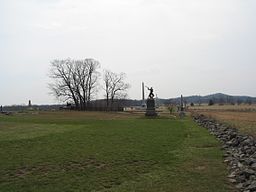High-water mark of the Confederacy
| High-Water Mark of the Confederacy | |
|
To the left (east) of The Angle stone wall was the farthest advances of the units of Longstreet's assault during the 1863 Battle of Gettysburg.
|
|
| Country | United States |
|---|---|
| State | Pennsylvania |
| County | Adams |
| NPS unit | Gettysburg National Military Park |
| Landform | Cemetery Ridge |
| Location | The Angle |
| - coordinates | 39°48.747′N 77°14.143′W / 39.812450°N 77.235717°WCoordinates: 39°48.747′N 77°14.143′W / 39.812450°N 77.235717°W |
| Establishing event |
Pickett's charge, July 3, 1863 |
The high-water mark of the Confederacy refers to an area on Cemetery Ridge near Gettysburg, Pennsylvania, marking the farthest point reached by Confederate forces during Pickett's Charge on July 3, 1863. Similar to a high water mark of water, the term is a reference to arguably the Confederate Army's best chance of achieving victory in the war. The line of advance was east of "The Angle" stone wall at various distances, e.g., the Virginians pushed the Union line back.
This designation was invented by government historian John B. Bachelder after the war when the monuments of the Gettysburg Battlefield were being erected. Some historians have argued that the battle was the turning point of the war and that this was the place that represented the Confederacy's last major offensive operation in the Eastern Theater.
On the third day of the battle (July 3, 1863), Confederate General Robert E. Lee ordered an attack on the Union center, located on Cemetery Ridge. This offensive maneuver called for almost 12,500 men to march over 1,000 yards of dangerously open terrain.
Preceded by a massive but mostly ineffective Confederate artillery barrage, the march across open fields toward the Union lines became known as Pickett's Charge; Maj. Gen. George E. Pickett was one of three division commanders under the command of Lt. Gen. James Longstreet, but his name has been popularly associated with the assault. Union guns and infantry on Cemetery Ridge opened fire on the advancing men, inflicting a 50% casualty rate on the Confederate ranks. One of Pickett's brigade commanders was General Lewis Addison Armistead. His men were able to breach the Union lines in just one place, a bend in the wall that has become known as "the Angle." This gap in the Union line was quickly closed with any Confederate soldiers who had breached it being quickly captured or killed, including Armistead.
...
Wikipedia

